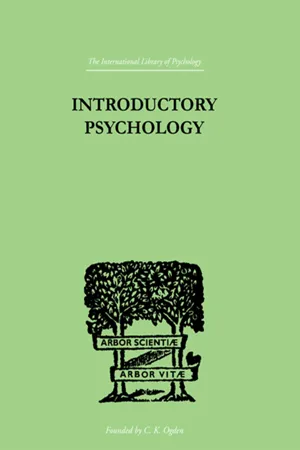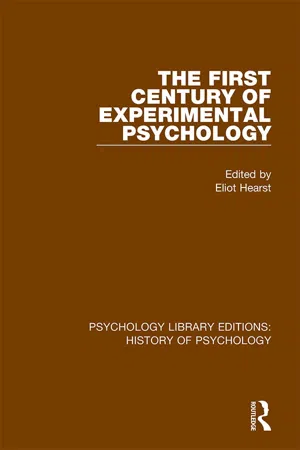Bruner and Minturn Study of Perceptual Set
The Bruner and Minturn study of perceptual set explored how expectations and past experiences influence perception. They found that people tend to perceive ambiguous stimuli in line with their expectations, demonstrating the role of mental sets in shaping perception. This study highlighted the influence of cognitive factors on how individuals interpret and make sense of the world around them.
5 Key excerpts on "Bruner and Minturn Study of Perceptual Set"
- eBook - ePub
Introductory Psychology
AN APPROACH FOR SOCIAL WORKERS
- D R Price-Williams(Author)
- 2013(Publication Date)
- Routledge(Publisher)
...In other words the picture of the outside world resumes its usual upright framework. This has been known to take place in so short a time as one week. This is because a person can rely on his kinaesthetic and tactual information to merge with the unusual visual impressions. It bears out strongly the contention that we literally have to learn to see what in fact we do see. Motivational Aspects If the evidence relating to learning in perception has shaken the copy theory, the material relating to suggestion and "set" indicates that the perceptual apparatus is even more pliable still. The role of suggestion is notorious and can be amusingly introduced with reference to an experiment made by Slosson 11 long ago. He opened a vial of distilled water before a chemistry class, informing the pupils that it contained a strong and powerful odour, and asked the class to put up their hands as soon as they smelled it. Whereupon a wave of hands rose up, starting from the front of the class and proceeding backwards. In fact the suggestion was so successful that some of the members of the class in the front seats complained that they felt ill and had to leave the room! Fink 12 also tells a story which further exemplifies the strength of suggestion. He had an asthmatic patient who complained that he was allergic to the smell of roses. When the patient saw a bowl of roses on the physician's desk he immediately had a paroxysm of coughing. The doctor then showed him that the flowers were made of paper. These two examples portray the effects of suggestion in excelsis, but the factor generally operates at a less obvious, and therefore more pernicious, level. Set. "Set" refers to the condition in which the organism is in a temporary state of readiness to respond to a stumulus. With regard to a previous set, less extreme examples of the fact that we see what we expect to see is afforded by the use of ambiguous figures. These are drawings which have two alternative interpretations...
- eBook - ePub
- Elliot Hearst, Eliot Hearst(Authors)
- 2019(Publication Date)
- Routledge(Publisher)
...(From Hochberg, 1978.) A. Gestalt Theory For the Gestalt psychologists, notably Max Wertheimer, Kurt Koffka, and Wolfgang Köhler, the elementary sensations were not only usually non-noticeable, as Helmholtz had proposed; they were completely fictitious, and resulted from artificially restricted experimental tasks and conditions. According to the Gestaltists, the real perceptual unit is the form. Form is a mental structure that takes its properties from underlying brain processes, or brain fields. These brain fields are presumably excited by the pattern of the stimulus acting on the nervous system (variously conceived as a complex electrical network or a colloidal bioelectric medium). The problem of explaining how the perception of a form remains unchanged despite its transposition to a new set of receptors (sometimes called the Gestalt problem) was “solved” by pointing out that the configuration of the object remains invariant while undergoing various transformations and that therefore the nervous system, which has evolved so as to respond directly to configurations, produces an invariant response—the perception of an unchanged form. This proposal, whether presented in the context of Gestalt theory or in more contemporary approaches like those discussed in Section IVC, is only a restatement of the observed phenomenon, of course, unless the mechanisms for responding to configurations or other invariants are spelled out. These hypothetical brain mechanisms, however, were and are quite inaccessible to direct investigation. The Gestalt psychologists assumed that because the organized configurations that we perceive must reflect the brain fields operating in the nervous system, the brain fields can be studied indirectly by their perceptual consequences—that is, by their effects on perceptual organization...
- eBook - ePub
Companion Encyclopedia of Psychology
Volume One
- Andrew M. Colman, Andrew M. Colman(Authors)
- 2018(Publication Date)
- Routledge(Publisher)
...Figure 4e is the Ponzo illusion (top) and the Poggendorf (bottom) Some aspects of perception can be understood if we know about the coding of features, as in colour vision or the elementary contour elements as studied by Hubel and Wiesel. Others require an understanding of how different cues, to depth and distance for instance, interact to affect what is seen (Figure 5). Still others, like the distorted room, require us to consider how our habits of thought and expectations-unconscious inferences-determine what we see. The study of illusion is like a workshop for the meshing together of all the different sorts of influence that bear on perception. Figure 5 Two illusions of size, induced by context; the one case by perspective (giving a false impression of distance, so "size constancy" is operative), in the other distortion is due to strong relative size cues Gestalt Psychology The study of illusions certainly seems to favour an eclectic and empiricist approach to perception. Yet there have been influential movements in psychology that have denied that position. Gestalt psychology was one of them; it asserted the primacy of organizational phenomena, yet denied the role of experience in building up perception. The German word Gestalt means "configuration", and identifies the main tenet of that school of psychology, namely that the nature of perception is holistic ; it is not to be understood by breaking it into elementary parts. The elements of Figure 6a and b for example fall "naturally" into a certain organization. We seem to have no control over this, and it occurs without effort on our part. The Gestalt psychologists maintained that this is no accident; for them the visual field was determined by a set of organizational principles that are simply a part of the way the brain works (Kohler, 1929). This school of psychology arose at a time when little was known about the operations of the visual brain...
- eBook - ePub
- Frank George(Author)
- 2015(Publication Date)
- Psychology Press(Publisher)
...The problem here for behaviourists is that we are assuming that one is some sort of measure of the other, which brings us into apparent conflict with such facts of behaviour as selection of stimulus and set. “Set” means that, from all possible stimuli in the environment, we tend to select, and often to expect, certain ones to occur. This purposive aspect of human behaviour has often been used as an argument against behaviourism, but is now thought to be evidence in favour of the fact that human beings are not merely passive victims of their environment, but active participators in it. Such a view has influenced the Transactionalists in perception, and the followers of Tolman in learning, without in any way impairing the essentially behaviouristic attitude adopted. O’Neil (1958) has tried to categorize the various points of view in perception in the following way. Discrimination theories, which include that view that talks in terms of primary perceptions or sensations and secondary perceptions or interpretations and this is perhaps represented best by Osgood and Skinner among modern theorists in the field of perception. The second group is called Phenomenalists and includes the Gestalt theorists (see next chapter), Gibson and Michotte, and finally the Judgmental Theorists who include Brunswik and Bruner. The first view is obvious enough and is essentially the one proposed in this book. The second is concerned with the appearances of things and one that has already been mentioned in philosophical terms, and the third is a view that directly relates perception to thinking. Drever (1960) adds a fourth category which he calls Adaptation theories which includes the work of Helsen and Kohler, and the view taken up in this book is that this is a typical example of different interpretations of the small perceptual facts all contributing something towards the general understanding of what the process entails...
- eBook - ePub
Perception, Learning and the Self
Essays in the Philosophy of Psychology
- D. W. Hamlyn(Author)
- 2022(Publication Date)
- Routledge(Publisher)
...It was argued by Kant in his discussion of the ‘schematism’ and it has been argued more recently by Strawson 6 that perception always involves the imagination in some way as a link between the abstract and formal understanding involved in having a concept and the concrete experience that sense perception brings. If that is so, the consideration is relevant to the point that I was making earlier – the fact that the look of things is influenced by our understanding of the kinds of thing that they are. The kind of use of the imagination that may influence the dawning of an aspect is, I think, different 7, though it may depend on the former. So far, I have considered factors on the side of the perceiver that may influence the way things look to him – his beliefs, his knowledge and understanding, the way in which his attention is directed, and his imaginativeness. There are of course additional factors on the side of the object or its context. A shift in what is literally a point of view may make an object look entirely different from how it has done hitherto, as may equally a change of context; it is in effect the latter which the Gestaltists emphasized so much, often to the exclusion of other factors which may in certain circumstances be just as important. What sort of account, however, can we give of the way in which these factors influence the look of a thing, when by ‘look’ we do not mean to imply anything about the beliefs of the perceiver with regard to the object? With this question we can go back to the kind of example that I instanced at the beginning in connection with Helmholtz. What sort of explanation should we look for in attempting to explain the facts of colour contrast? The answer may seem obvious. This is a phenomenon where context is obviously important, and we might well look for the explanation in the facts of sensory stimulation and the background physiology...




